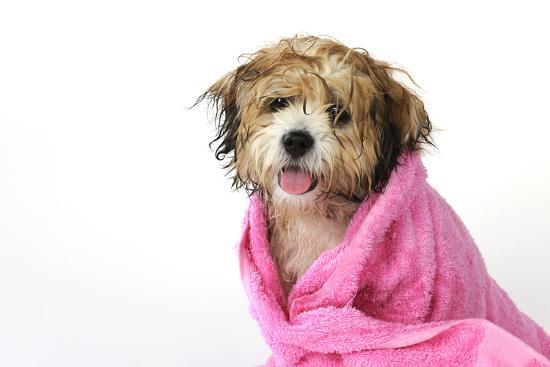Towel drying is something that must be done in the first instance before your dog leaves the bath. The reasons for this are twofold. First, if the dog leaves the bath dripping water everywhere, the floor will become wet and slippery, which is dangerous for all concerned.
Secondly, in order to protect the skin, as much water as possible needs to be removed before exposing the skin to artificial heat.
There are a few things to consider when you are drying a dog with towels:
- If the skin is very sore or the hair coat is very thin (alopecia), do not rub with your towel. Instead, blot the coat and keep blotting until the coat is as dry as possible.
- If the dog has a long coat,use an up-and-down motion with your towels rather than a circular motion, as the latter will knot the coat.
- A short coated dog can be dried with either a circular motion or an up-and-down motion, in both cases lifting the coat towards the head to dry the skin.
You need a high-absorbency cloth (this type of cloth is used damp, and can absorb many times its own weight in water; it will need wringing out frequently) and at least one dry towel.
With all dogs that have some length of coat, you should restrict yourself to blotting the coat with your towel or working in an up-and-down motion. Rubbing the coat in circles will promote knots and tangles. Smooth coated dogs won’t have this problem, so circles are fine!
Start by drying the head and face first, particularly with longer-coated breeds so that water does not drip into the eyes. This is particularly important if you have used a conditioner because these products often leave a residue after rinsing to protect the hair and aid grooming.
A similar situation may arise following the use of a VPOM shampoo, which is designed to leave a chemical/ medicinal residue in the coat.
Dogs shake to remove water from their head and ear regions, so once the face and ears are dry, they are less inclined to shake violently or as often. This helps you keep control over where all the water goes, rather than leaving it up to the dog!
From the head, work your way down the back and the body using your cloth in a backwards-and-forwards motion (head to tail and back again). Gravity pulls water down towards the feet so the back tends to dry quite quickly. This does mean, though, that drying the legs and feet is more time-consuming whether the dog has a long or short coat.
work your way down the back and the body using your cloth in a backwards-and-forwards motion (head to tail and back again). Gravity pulls water down towards the feet so the back tends to dry quite quickly. This does mean, though, that drying the legs and feet is more time-consuming whether the dog has a long or short coat.
Blot the legs repeatedly, wringing out your cloth frequently, particularly if you are drying long coats. The longer back legs can be blotted or rubbed up and down, but remember to resist the temptation to make circles over the rump and the tops of the legs.
When there are no longer any drips coming from the coat, use your towel to repeat the process. The dog is now ready for blasting or drying.
There are some instances where it is not possible to use any form of heat. This includes dogs with skin conditions that will be aggravated if heat is applied. Sometimes dogs that are very sensitive to noise may need to be towel dried from start to finish if the dryer cannot be tolerated.
It is acceptable to leave the dog to dry, providing the environment is warm and free of draughts, but in winter it may be necessary to use towels to dry the dog. You are likely to need several towels but good use of a high-absorbency cloth will help to reduce the amount that you use.
Towel drying should be interrupted periodically to brush the coat so that any developing knots are removed.
Confine the dog to a bed covered in towels. Evaporation from the warming skin will help to finish the drying process. Change the towel frequently so that the dog is not lying on a wet patch and encourage the dog to turn over and lie on the opposite side when the bedding is changed.
If it is not possible to get the dog completely dry with towels, pay particular attention to the drying of the ears, and the lumbar back region, as these are the areas where the dog will feel the cold first. Keep the dog in a warm room until drying is complete.
If the dog is long coated, it may be wise to brush or ruffle the coat periodically to lift it from the skin, thus allowing the skin to dry as quickly as possible.
Towel drying is the preferred way to dry damaged skin, and it minimizes skin damage from over-exposure to a heat source. The disadvantages are that it is time-consuming and generates a lot of laundry, and a naturally dried coat is not necessarily prepared correctly for styling.

